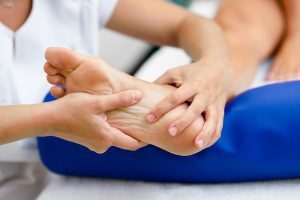

Arthritis can cause severe pain in the joints of your feet. It’s a common disability for many American adults. Although arthritis is a degenerative disease, you can manage symptoms and maintain an active lifestyle free of discomfort with advanced foot arthritis treatment at the Foot, Ankle & Leg Vein Center, award-winning podiatry in Boca Raton, FL.
Arthritis can be the result of trauma or high mechanical stress to a joint. Over time, the joint space will become narrowed and cartilage that covers a joint surface will be stripped. Spurs or bone fragments can occur around the joint as well, which can lead to pain and often a hot and swollen joint.

Medical massage at the foot in a physiotherapy center. Female physiotherapist inspecting her patient.

A few different forms of arthritis can affect the foot, each with different risk factors and causes.
To determine the source of your arthritis and find an effective form of foot arthritis treatment, Dr. Schoenhaus and Dr. Gold will perform an in-depth analysis of your medical history and the nature of your discomfort. They will ask when and where the pain occurs, as well as any recent injuries and lifestyle factors like footwear and medication use. Dr. Jodi Schoenhaus and Dr. Jason Gold may also use diagnostic procedures like gait analysis, X-rays, CT scans, or MRIs to evaluate your arthritis.

If you suffer from foot arthritis, Dr. Schoenhaus and Dr. Gold can help you find the most effective treatment for your condition. Contact our office to set up a consultation today.
Your questions answered
Foot arthritis can be the result of trauma or high mechanical stress to a joint. Over time, the joint space will become narrowed and cartilage that covers a joint surface will be stripped. Spurs or bone fragments can occur around the joint as well, which can lead to pain and often a hot and swollen joint.
You may be suffering from foot arthritis if you experience: • Swelling • Limited motion • Tenderness, pain, or stiffness • Walking difficulties due to other symptoms above
Types of foot arthritis include: Osteoarthritis: Osteoarthritis refers to the gradual wearing down of the cartilage in the joints. The risk of developing osteoarthritis increases with age because our cartilage becomes less able to repair itself as we get older, making it a common problem during and after middle age. Contributing factors to osteoarthritis also include family history and obesity. Post-traumatic arthritis: Post-traumatic arthritis can occur after a sprain, fracture, dislocation, or other injuries. Even with proper treatment, joints are at a higher risk of arthritis after injury and can sometimes develop the condition years after the trauma. Rheumatoid arthritis: Rheumatoid arthritis is a disease in which an individual’s immune system seeks out and destroys cartilage. Instead of affecting specific joints, rheumatoid arthritis tends to be a whole-body problem. Though the cause is not known, certain genetic factors may increase your risk while environmental factors can trigger the issue.
Foot arthritis can be diagnosed through X-rays, CT scans or MRIs, medical history, and physical examination.
Surgical care for foot arthritis includes: